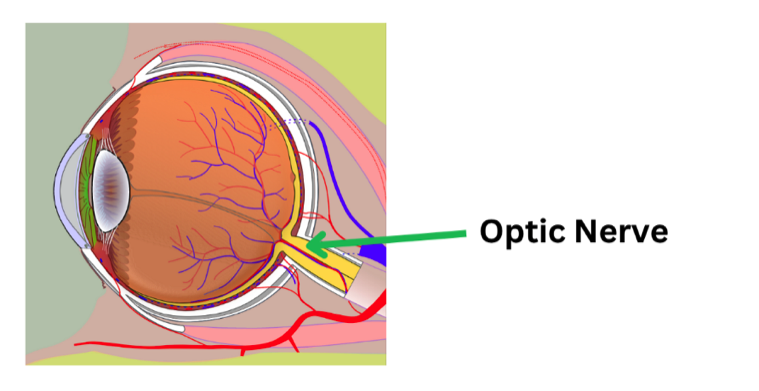Site by Constant Creations
What is Optic Neuritis?
Optic Neuritis is an inflammatory condition affecting the optic nerve, which can lead to acute vision loss. The optic nerve transmits visual information from the eye to the brain, and inflammation in this nerve disrupts this process.
The term ‘Optic Neuritis’ typically refers to the most common form, idiopathic demyelinating optic neuritis (IDON). Demyelination occurs due to inflammation of the ‘myelin’, a fatty sheath which insulate our nerve fibres, disrupting the normal flow of electrical impulses along nerve fibres.
Multiple Sclerosis (MS) is one such demyelinating condition and the most common cause of IDON. Multiple Sclerosis is a chronic auto-immune condition affecting the brain and spinal cord. Symptoms and severity of the condition vary depending on the location and extent of nerve damage but can include poor co-ordination, fatigue, numbness and weakness. The disease can cause patterns of relapse and remittance. In some individuals it may worsen progressively. Multiple sclerosis is most common in females and in individuals aged 18-45.
Support and information for individuals with multiple sclerosis is provided by MS Australia, and can be accessed at this link: What is Multiple Sclerosis (MS) - MS Australia
Causes of Optic Neuritis
There can be causes other than the demyelinating conditions usually associated with Optic Neuritis.
Antibody-associated Optic Neuritis is one sub-type which occurs due to the presence of certain antibodies in the body, such as MOG and AQP4 in NeuroMyelitis Optica (NMO).
Optic neuritis may be a secondary result of an infection or of other autoimmune diseases, but this is more rare.
Symptoms of Optic Neuritis
Symptoms of optic neuritis typically develop rapidly, over hours to days, and can include:
• Vision loss in one eye, which can range from mild to severe
• Pain, particularly headaches behind the eyes, often made worse with eye movement.
• Reduced color vision where colors may appear less vivid
Treatment
Treatment of idiopathic demyelinating optic neuritis often involves:
• Corticosteroids: High-dose intravenous corticosteroids (e.g., methylprednisolone) followed by oral corticosteroids can speed up recovery. Steroid treatment does not influence the extent of recovery, though recovery is usually excellent.
• Managing underlying conditions: If optic neuritis is associated with multiple sclerosis or another autoimmune disease, treating that condition is also necessary.
• Observation: In some cases, optic neuritis may resolve on its own without treatment.
Prognosis
The prognosis for optic neuritis varies.
• Recovery: Many patients experience substantial or complete recovery of vision within a few weeks to months. However, some degree of visual impairment, particularly in color vision, may persist.
• Recurrent episodes: Patients with multiple sclerosis or neuromyelitis optica are at higher risk of recurrent episodes of optic neuritis, which can lead to cumulative damage and more significant long-term vision loss.
Long term monitoring
Long-term monitoring for sufferers of optic neuritis is required to prevent further relapses or changes, including neurological damage related to associated conditions.


